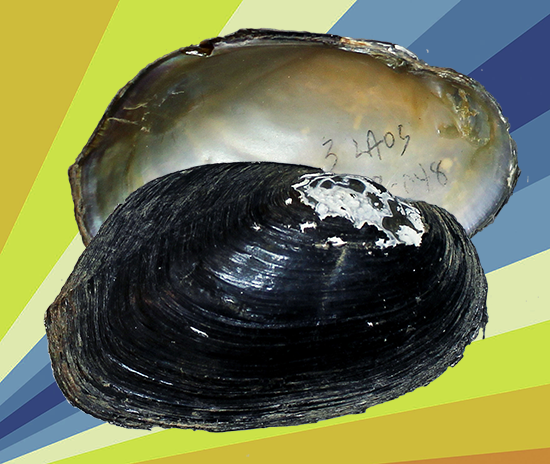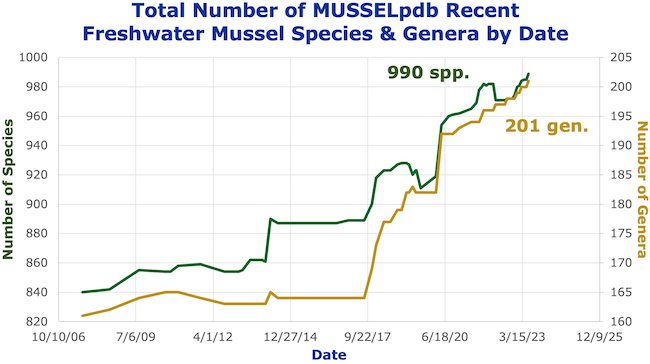| Page last updated
5 July 2023 |
Mussel of the Month
The July 2023 Mussel of the Month is Nyeinchanconcha nyeinchani. Nyeinchanconcha is a monotypic genus endemic to the Mekong Basin in Laos.

UMMZ 304648. Nam Phiat, Phonethong, ca. 2 km from confluence,
Bolikhamxai Province, Laos. (paratype)
|
The selection of Nyeinchanconcha nyeinchani for July 2023 marks 20 years of Mussels of the Month — 240 consecutive months of freshwater malacological info-tainment! The pie graph below summarizes the distributions of all the Mussels of the Month by family, and the summary page provides links to them all!
We chose Nyeinchanconcha nyeinchani for this month because it is symbolic of the change in freshwater mussel systematics that has happened over these 20 years.
Back in 2007, when we published our first global checklist of freshwater mussel species (Graf & Cummings, 2007), we lamented the slow pace of genus- and species-level revisions based on phylogenetic data. The genus Reginaia provides an illustrative example. It was discovered by Lydeard et al. (2000) that "Fusconaia" ebenus and "Obovaria" rotulata grouped with each other rather than with their traditional genera, but a new genus name wasn't introduced for a dozen more years (Campbell & Lydeard, 2012).
Of course, taxonomic change didn't always take that long. For instance, Campbell et al. (2005) discovered the phylogenetic affinity of "Fusconaia" barnesiana, "Pleurobema" gibbum, and "Lexingtonia" dolabelloides, and Pleuronaia was in use within a few years (Williams et al., 2008). In that case, there was already a genus-group name available.
The graph at the bottom of this page plots the change in the numbers of valid species and genera since 2007, and the increase in both species and genera is evident. Both lines really take-off in 2017. The surge in the number of species by about 100 and genera by more than 40 was fueled by several phylogenetic studies, especially those dealing with East Asia and North American taxa. Researchers were sequencing more specimens and publishing larger phylogenies than before (e.g., Lopes-Lima et al., 2017 and Bolotov et al., 2017a, b and many more), and they were quicker to put-right prodigious polyphyly (and paraphyly) by nimbly nominating new nomenclature to maximize monophyly. While our most recent checklist was being drafted (Graf & Cummings, 2021), the number of species increased by 43, and we needed to accommodate 10 more genera. Since then, we have gained about that many more of each!
That brings us to Nyeinchanconcha nyeinchani. This monotypic genus was named for two lots of specimens from the Mekong Basin in Laos (both collected by Maurice Kottelat). One was genotyped and analyzed phylogenetically by Pfeiffer & Graf (2015) and the other by Lopes-Lima et al. (2017). Both studies identified their specimens as Pseudodon cumingii. However, the more comprehensive analysis of Bolotov et al. (2020) recovered those specimens on their own branch — distinct from other Sundadontina cumingii (the new genus they introduced for the species). To resolve the incongruence, those specimens were renamed Nyeinchanconcha nyeinchani right then and there — no more problematic polyphyly!
The history of phylogenetic analysis of Nyeinchanconcha nyeinchani can be seen on the Pilsbryoconchina cladomics page on this web site! |
|
Classification:
Phylum Mollusca
Class Bivalvia
Subclass Palaeoheterodonta
Order Unionoida
Superfamily UNIONOIDEA Rafinesque, 1820
Family UNIONIDAE s.s.
Subfamily GONIDEINAE Ortmann, 1916
Tribe PSEUDODONTINI Frierson, 1927
Subtribe PILSBRYOCONCHINA
Bolotov, Vikhrev & Tumpeesuwan, 2017
Genus Nyeinchanconcha Bolotov, Konopleva, Vikhrev, Gofarov,
Lopes-Lima, Bogan, Lunn, Chan, Win, Aksenova, Tomilova,
Tanmuangpak, Tumpeesuwan & Kondakov, 2020
Species Nyeinchanconcha nyeinchani Bolotov, Konopleva,
Vikhrev, Gofarov, Lopes-Lima, Bogan, Lunn, Chan, Win,
Aksenova, Tomilova, Tanmuangpak, Tumpeesuwan & Kondakov, 2020 |
To find out more about the phylogenetics and classification of Nyeinchanconcha and Reginaia (and other recently described genera), check out:
- Bolotov, I.N., A.V. Kondakov, I.V. Vikhrev, O.V. Aksenova, Y.V. Bespalaya et al. 2017a. Ancient river inference explains exceptional Oriental freshwater mussel radiations. Scientific Reports 7. 2135 (14 pp.).
- Bolotov, I.N., I.V. Vikhrev, A.V. Kondakov, E.S. Konopleva, M.Y. Gofarov et al. 2017b. New taxa of freshwater mussels (Unionidae) from a species-rich but overlooked evolutionary hotspot in Southeast Asia. Scientific Reports 7. 11573 (18 pp.).
- Bolotov, I.N., E.S. Konopleva, I.V. Vikhrev, M.Yu. Gofarov, M. Lopes-Lima et al. 2020. New freshwater mussel taxa discoveries clarify biogeographic division of Southeast Asia. Scientific Reports 10. 6616 (22 pp.).
- Campbell, D.C. & C. Lydeard. 2012. Molecular systematics of Fusconaia (Bivalvia: Unionidae: Ambleminae). American Malacological Bulletin 30(1): 1-17.
- Campbell, D.C., J.M. Serb, J.E. Buhay, K.J. Roe, R.L. Minton & C. Lydeard. 2005. Phylogeny of North American amblemines (Bivalvia, Unionidae): prodigious polyphyly proves pervasive across genera. Invertebrate Biology 124(2): 131-164.
- Graf, D.L. & K.S. Cummings. 2007. Review of the systematics and global diversity of freshwater mussel species (Bivalvia: Unionoida). Journal of Molluscan Studies 73: 291-314.
- Graf, D.L. & K.S. Cummings. 2021. A ‘big data’ approach to global freshwater mussel diversity (Bivalvia: Unionoida), with an updated checklist of genera and species. Journal of Molluscan Studies 87(1). eyaa034 (36 pp.).
- Lopes-Lima, M., E. Froufe, V.T. Do, M. Ghamizi, K.E. Mock et al. 2017. Phylogeny of the most species-rich freshwater bivalve family (Bivalvia: Unionida: Unionidae): Defining modern subfamilies and tribes. Molecular Phylogenetics and Evolution 106: 174-191.
- Lydeard, C., R.L. Minton & J.D. Williams. 2000. Prodigious polyphyly in imperilled freshwater pearly-mussels (Bivalvia: Unionidae): a phylogenetic test of species and generic designations. [in] The Evolutionary Biology of the Bivalvia (Harper et al., eds.). Geological Society, London Special Publications 177: 145-158.
- Pfeiffer, J.M. & D.L. Graf. 2015. Evolution of bilaterally asymmetrical larvae in freshwater mussels (Bivalvia: Unionoida: Unionidae). Zoological Journal of the Linnean Society 175(2): 307-318.
- Williams, J.D., A.E. Bogan & J.T. Garner. 2008. Freshwater Mussels of Alabama and the Mobile Basin in Georgia, Mississippi and Tennessee. University of Alabama Press, Tuscaloosa. 908 pp.

|